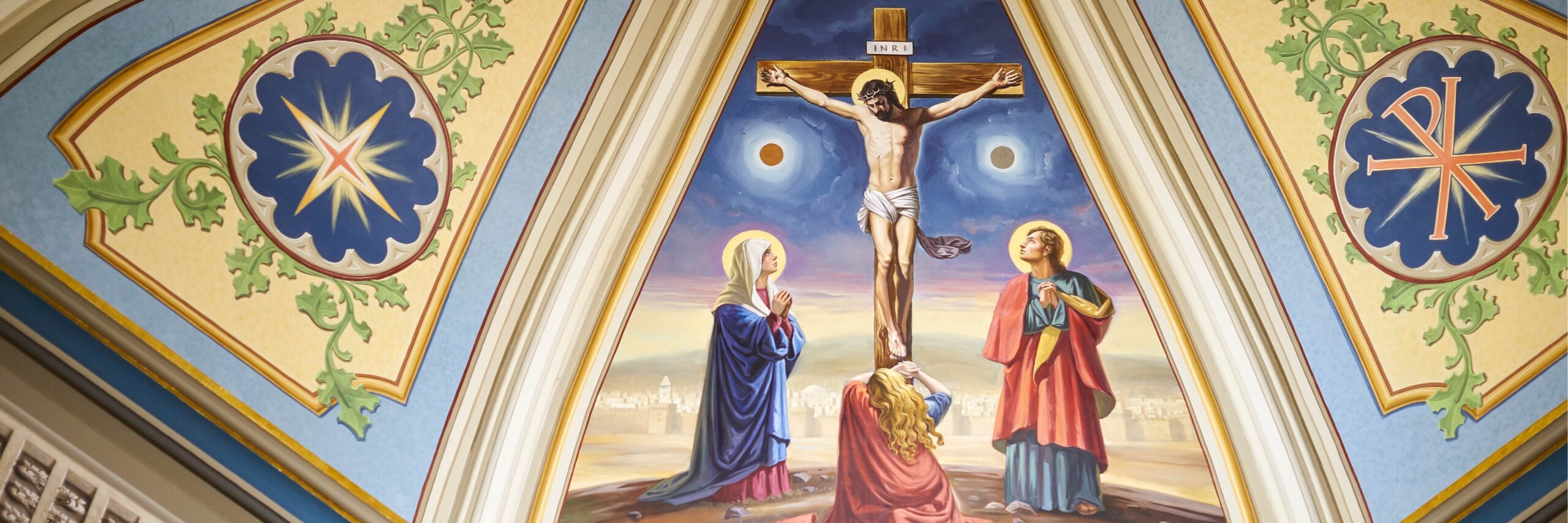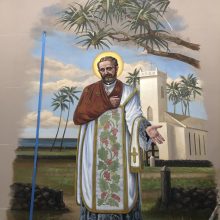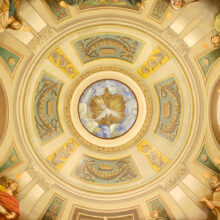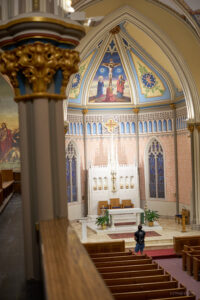
I recently stumbled across this photo of St. Peter the Apostle Parish in New Brunswick, New Jersey while researching EverGreene’s work at student chapels. Even in a sea of expansive murals and historic architecture photos at schools across the country, I found this one to be the most striking. While we prioritize photos that emphasize the technical and artistic talent of our team, this photo is equally important because it comments on the impact of our work.
With a background in photography, I look at photos as if I am the photographer aligning the frame, analyzing each compositional element; looking at this photo is no different. I think the most important detail the photographer captured is the person facing the altar, which doesn’t seem to be a mere accident or result of a rushed effort. The empty pews indicate that the photographer wouldn’t have had to wait long for a clear picture of the church. Perhaps they were waiting for such a person to walk into the frame to offer context about the purpose of the space.
Although the featured individual is fairly indistinct, it’s very likely he’s a student, considering the church is on the campus of Rutgers University. With his head raised to the mural of the Crucified Christ, Blessed Mother, and Beloved Disciple, is he contemplating God, analyzing the painting technique, or just thinking about how much homework he has to do later? Although we don’t know his interior disposition and response, or lack thereof, to the painting, it’s certain that something about the artwork has captured his attention, otherwise he wouldn’t have paused long enough for the photographer to compose such a thoughtful image.
The photograph is a simple example of how excellent sacred art can draw us into the mysteries of Catholicism and spark curiosity about the eternal. Artistic depictions of the life of Jesus, the saints, and sacraments are powerful because they are captivating but not confrontational. Rather, religious art is a gentle invitation to consider the hidden reality it represents, quieting a tendency to immediately oppose that which we can’t yet fully grasp. Even so, sacred art doesn’t dull our reason, but engages it, welcoming us to ponder the seen as a window to the unseen. As Saint Paul VI expressed in a brief address to artists in 1965, authentic art “mak[es] the invisible world palpable.” It’s therefore not surprising that the Catholic Church has continually emphasized evangelization through beauty.
This quiet yet compelling voice of beauty belongs particularly on college campuses. With newfound independence, college students can explore and strengthen their beliefs and values; the environments students frequent undoubtedly play a role in this process. Just as students who seek to excel in academics benefit from a classroom and library, students who seek to develop their religious beliefs benefit from a designated gathering place. Student chapels and centers are one of the only places at secular universities dedicated to students’ religious development and spiritual encouragement, as well as the cultivation of rich tradition and community.
One of many ways to invite students into these meaningful spaces is through sacred art. In a lecture to students at the New York University Catholic Center, Bishop James Conley of Lincoln, Nebraska — in whose diocese we have completed several projects — commented on the transformative power of beauty. “Knowing and loving Christ,” he said, “begins with seeing glimmers of divinity in the beautiful things of this world.” Great religious art, then, is not merely an end in itself, but a mere reflection of and gesture to the source of all beauty, kindling a wonder of God that can stop us in our tracks, much like the Rutgers student discussed above. Beautiful chapels can stand out to students because it’s likely that most, if not all, campus buildings aren’t quite so magnificent.
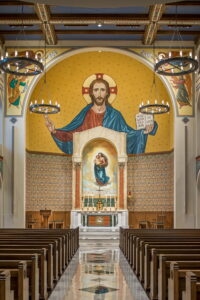
EverGreene’s artwork at St. Paul’s Chapel at the University of Wisconsin is a comprehensive example, offering to students a glimpse of the characteristics of Jesus and the saints. Christ the Teacher emblazons the apse in gold leaf and vibrant colors, projecting authority and grace. Accompanying Him is an array of mosaics depicting the saints, inviting students to contemplate their own unique call to courage, compassion, and endurance. Like busts of academics that signify intellectual achievement, so too art of the saints displays spiritual heroism. The media EverGreene artists and artisans have used to create depictions of the saints are just as varied as the saints themselves. From bas reliefs of the Coronation of Mary to faux tapestries of English martyrs, these creations are expressions of excellence that are rarely found, or altogether absent, in buildings at secular schools.
As art of the saints points to a heavenly community, student chapels uphold a human one. These spaces give young Catholics the opportunity to celebrate mass together and immerse themselves in a dynamic environment of spiritual growth, friendship, and service. The most impactful part of my involvement with the Catholic Student Association at Northeastern University has been sharing my faith with and learning from the community members, which is strengthened by our ability to gather in a common place. And although our center is housed in a small Boston brownstone, the size of the space doesn’t hinder us. While I hope future Northeastern students can gather in a chapel that resembles even a shadow of the nearby Cathedral of the Holy Cross, it is our shared purpose that matters most and endures.
Authored by Abigail Hembree, marketing intern at EverGreene and undergrad at Northeastern University studying journalism and photography.
